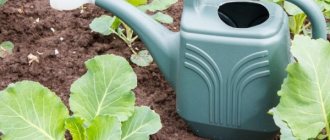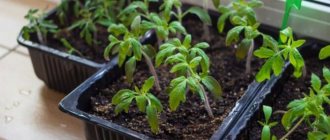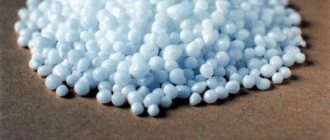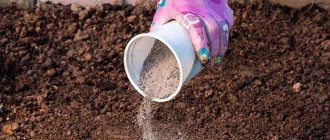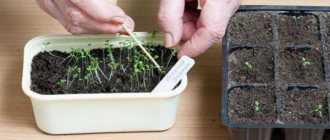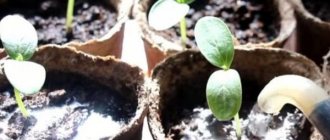Like any other seedlings, seedlings of white cabbage, cauliflower or Chinese cabbage need feeding at certain stages of their growth.
With the help of fertilizers, we help seedlings gain strength before planting in the beds. Dear readers!
For you, we have created communities on social networks in which useful articles and interesting ideas are published several times a day! Subscribe and receive useful content in a convenient format! In today's article we will talk about how to fertilize cabbage at various stages of the growing season while growing seedlings. In addition, you will learn which fertilizers are better and what “grandmother’s recipes” can be used.
When to feed cabbage seedlings
While cabbage seedlings are growing in containers or cups at your home, you need to have time to carry out several feedings.
Fertilizers can be applied for the first time at the stage of appearance of 2 true leaves. But it’s too early to apply full-fledged fertilizers. The root system has not yet matured enough to fully absorb nutrients.
The second feeding (and if the seedlings are good, then it will be the first) is carried out 8-12 days after picking.
The next time fertilizers are applied 12-15 days after the previous feeding.
And finally, for the fourth and last time, the cabbage needs to be fed just before planting in the garden.
In total, 3-4 feedings are obtained for the entire time of growing seedlings. In fact, no more is needed. Excess mineral components are also harmful to plants. If your seedlings look healthy and plump, then you can do without fertilizing.
The correct soil composition is the basis for successful growing of seedlings
For active growth and development of cabbage, quite a lot of different organic and inorganic substances are needed, from which plant tissues are formed. Moreover, if organic compounds are formed during the process of photosynthesis, then the bush receives inorganic compounds exclusively from the soil. Cabbage roots absorb elements that are extremely important for its development:
- phosphorus and calcium, which promote growth;
- nitrogen, which strengthens the leaves;
- potassium, which takes an active part in the ovary and growth of the head of cabbage;
- copper, which enhances protein and carbohydrate metabolism in living tissues of vegetation.
It is worth noting that not every gardener periodically applies fertilizers to his plot of land. As a result, the reserves of these elements in the soil are gradually depleted. And this especially affects the growth of seedlings.
To prevent this outcome, separate soil is prepared for sowing seeds. When planting white and red cabbage varieties, fine sand, turf soil and humus are mixed in equal proportions. To improve the quality of the earthen mixture, add to it for every 10 kg:
- 50 g of potassium sulfate;
- about 70 g of chicken egg shells, which are pre-crushed to a powdery mass;
- 70 g superphosphate;
- a glass of ash.
To grow red cabbage seedlings, the appropriate container is filled with a mixture of peat, fine sand and humus. Of the additional components, only wood ash is added, increasing its volume to 1.5 cups.
How to determine that cabbage seedlings need feeding
A lack of micronutrients can be determined by the appearance of cabbage seedlings.
Pale, limp plants with thin stems and translucent leaves - all this signals that the seedlings need to be fed.
Nitrogen deficiency manifests itself as yellowing of leaves. If cabbage lacks potassium, the seedlings become wrinkled. Phosphorus deficiency manifests itself in darkening of the leaf blades of seedlings. With a lack of calcium, light spots appear and the leaves begin to curl downwards.
Disinfection of cabbage seeds before sowing
In order for healthy and strong seedlings to grow from cabbage seeds, you need to properly prepare the seed. The fact is that most diseases of vegetable crops are transmitted through seed and planting material.
Do you want to get healthy cabbage seedlings? Then, before sowing the seeds, be sure to carry out the disinfection procedure. This can be done in several ways, by heating the seeds or pickling them in a pink solution of potassium permanganate.
Only coated seeds do not need to be processed. Manufacturers have already taken care of them; all that remains is to sow the material in the prepared soil.
- Preparing seeds for sowing: what do you need to remember?
Prepare seeds for sowing correctly!
What to feed after germination, when to do the first feeding
When the seedlings produce the first pair of true leaves, you can add a little Agricola to them (you need a specialized one for cabbage). This is a balanced drug, which rather functions as a growth stimulator than as a full-fledged feeding.
IMPORTANT! This and any subsequent root feeding of seedlings must be carried out on wet soil. Otherwise, there is a risk of burning the roots of the plants.
Early and late varieties: what is the difference in care?
Early and late cabbage differ not only in terms of ripening, but also require different care. If, for example, early cabbage needs to be watered abundantly in June, then late cabbage needs to be watered abundantly in August.
Important!
Early cabbage seedlings should be planted in the ground from April 20 to May 5, and late varieties of cabbage should be planted from May 25 to June 5.
But what about feeding? Is it different?
- Late cabbage needs to be fertilized more often than early cabbage . Typically, early varieties do not require more than 2-3 feedings. Even 2 feedings with a frequency of 20 days are enough for her. And for later varieties, a little more feeding will be required - 3-4 times with a frequency of 15-25 days.
- Early cabbage needs less fertilizer than late cabbage . When you carry out the first fertilizing, for example, with ammonium nitrate, then for early cabbage you will need 0.5 tbsp. spoons of saltpeter per 10 liters of water, and for later - 2 tbsp. spoons per 10 liters of water.
How to feed cabbage seedlings after picking
You should plan your first fertilizing with real fertilizers after the dive. And not immediately after the procedure, but after a week, or even two. Immediately after picking, the roots are not yet able to fully absorb useful microelements from the soil. Therefore, you need to wait and then water the seedlings with nutrient mixtures.
If you grow seedlings in separate containers, then you need to plan a similar feeding for the phase of appearance of 2 pairs of true leaves.
Now let’s figure out what mixtures need to be used to saturate plants with the required amount of nitrogen, potassium, phosphorus and other microelements.
Take a 3 liter jar of water and pour the following mixture into it: 6 grams of saltpeter, 6 grams of potassium chloride, 12 grams of superphosphate. The water should be warm and settled. Water a little at a time. If this amount of fertilizing is excessive, then reduce all components by 2 or 3 times.
The second feeding is carried out 2 weeks after the first.
It is necessary to use preparations with a high nitrogen content. Alternatively, ammonium nitrate. For a three-liter jar you will need 10 grams of the drug. Nitrate can be replaced with urea or regular ammonia, which is also a source of nitrogen.
Shoots have appeared - what next?
The first feeding after germination is carried out when the seedlings have 2 full cabbage leaves. For this purpose, it is better to use a balanced mixture from a gardening store; you can use the preparation “Agricola” (for cabbage and cauliflower).
The package is diluted in the doses specified by the manufacturer, and watering is best done using a watering can with a mesh - this way, undissolved granules will not get into the soil. You can consider other compositions from trusted manufacturers, but you need to pay attention to the components of the mixture. These should include molybdenum and boron.
After 2 weeks, the plants can be transplanted (picked). If ordinary cultivated garden soil is used for this purpose, it must be enriched by adding additional ash and superphosphate in the amount of 2 tbsp. (volume is indicated for 10 liters of soil).
Advice! Fertilize the soil a few days after planting.
What kind of fertilizing is needed for cabbage before planting in open ground?
Before you take containers with seedlings to the garden for planting, the seedlings need to be strengthened so that they can easily withstand this procedure.
Complex formulations are suitable for this. You can prepare this yourself. For 5 liters of water you will need 10 grams of potassium chloride, 15 grams of saltpeter and 25 grams of superphosphate. Of the purchased drugs, Kemira will give a similar effect.
Soaking cabbage seeds
Before sowing, cabbage seeds should not only be disinfected, but also soaked in water so that they germinate faster. It is best to use melt or rain water for this procedure. Cabbage seeds are pre-soaked for 17-19 hours. For convenience, you should wrap the seeds in a piece of cloth (tying it like a bag) and place it in a container with water.
Some gardeners freeze water in the freezer and then place ice cubes or pieces in a wide bowl, let them melt and then drop the seeds into this water.
To stimulate the accelerated germination of cabbage seeds, you can add biological products to the water: Epin or Heteroauxin. If these products are not at hand, you can add aloe juice to the water.
It is advisable to replace the water in the container once every 3-4 hours. After soaking, the cabbage seeds need to be dried a little - and you can sow them.
What fertilizers can be used at home?
Let's look at the main types of fertilizers that are used to feed cabbage seedlings at home.
Complex formulations
These are preparations that contain all the most important micro- and macronutrients. For white cabbage, cauliflower, Chinese cabbage and kohlrabi, you can choose Clean Leaf, Nitroammofoska, Kemira, Omu, Prompter, Gaspadar. These are essentially similar drugs. Therefore, you only need to choose one of them.
Mineral preparations
Mineral preparations are necessary for the growth of leaves and shoots, as well as to maintain the overall tone of the plant and strengthen its health.
Cabbage loves all the essential minerals. For example, urea, ammonium nitrate as a source of nitrogen; superphosphate as a source of phosphorus; potassium salt and potassium sulfate as a source of potassium compounds.
Mineral preparations are good because of their availability. Also, to feed cabbage seedlings you need very small amounts of each drug. Therefore, by purchasing, for example, a package of each of the products listed above, you will provide food to all your seedlings for the entire growing period.
Organic fertilizers
- Chicken droppings. Powerful complex fertilizer. Now sold in dry bags. Before use, you need to prepare a concentrate and make a working solution from it.
- Mullein. Source of nitrogen. But it is not advisable to use it at home due to its specific smell.
- Ash contains a whole range of useful microelements. Many summer residents use exclusively ash and solutions based on it for nutrition.
Problems during cultivation
Cabbage is quite sensitive to growing conditions, which can result in certain problems if not properly cared for.
The seedlings stretched out
Pulling seedlings is a common occurrence. There are usually several reasons for this problem:
- lack of light;
- heat;
- excess nitrogen fertilizers in the soil.
Cabbage seedlings stretch out in low light
To ensure normal lighting, it is necessary not only to install an additional source, but also to use reflective materials (white paper, foil). As for temperature, cabbage does not like heat, much less heat. Under unsuitable conditions, it not only stretches out, but even dies. Therefore, it is necessary to ensure appropriate temperature conditions.
If plants receive an excess amount of nitrogen, the leaves develop to the detriment of the root system. This indicates the need to stop fertilizing with nitrogen until the seedlings are planted in the ground.
Seedlings don't grow
The reason why cabbage seedlings do not grow at home lies, as a rule, in low humidity and high temperature. To ensure normal conditions, it is best to place the seedlings in a greenhouse, where it is much easier to create the necessary microclimate.
The lower part of the stem dries out
The problem of the lower part of the stem drying out is caused by a lack of moisture in the soil, thickened plantings and too dry air. All these factors indicate the need to create and maintain optimal conditions for young plants. Cabbage is a moisture-loving crop that requires regular and moderate watering, and if planted too densely, the seedlings simply do not have enough moisture. In this case, the seedlings need to be thinned out and the stems lightly sprinkled with soil.
Cabbage is a moisture-loving crop
To increase humidity levels, plants need to be sprayed periodically.
The seedlings are withering
There are also situations when the leaves of young cabbage wither. The reason may be excessive watering and lack of loosening of the soil, which results in the formation of a soil crust through which the supply of oxygen to the roots is difficult. In this case, the roots of the plants rot and the leaves wither. In addition, it would be useful to inspect the drainage holes of the planting containers. If they are clogged, then the water simply has nowhere to drain. The cause of wilting can also be caused by inappropriate soil acidity.
The reason cabbage seedlings wilt can be caused by a lack of oxygen, too much moisture in the soil, or inappropriate acidity.
Folk remedies for cabbage seedlings
It is not necessary to use purchased products to feed the seedlings. Among folk remedies, there are also decent fertilizers that will saturate the seedlings with the necessary elements. Let's look at the most popular of them:
- Boric acid solution. This is a preparation for foliar treatment. To obtain the concentrate, you will need a teaspoon of powder and a full glass of very hot water. The finished concentrate is dissolved in a ten-liter bucket of water and the seedlings are sprayed with it. If 10 liters of water is too much for you, then reduce the amount when preparing the concentrate.
- Soda. The working solution is prepared from 4 tablespoons of soda and half a glass of water. Can be used throughout the growing season.
- Infusion of young nettle. This is an effective green fertilizer that contains a powerful dose of nitrogen. The infusion is prepared within a week. Then it is diluted with water in a ratio of 1 to 10. It is used for root feeding.
- Ammonia. For a three-liter jar you need 3 teaspoons of ammonia. The finished product must be prepared immediately after mixing.
- Yeast. Considered an excellent growth stimulant. First, prepare a concentrate from 1 liter of water and 1 g of yeast. The mixture is kept for 4 hours and then diluted with 3 liters of water. The fertilizer should be applied immediately on the day of production.
Feeding according to “grandmother’s” recipes
You can fertilize cabbage seedlings not only with industrial preparations. The culture reacts responsively to applied supplements prepared according to recipes called folk remedies.
Let's consider popular options:
- Boric acid. To prepare the solution you will need the drug in powder - 1 tsp. The substances are dissolved in 200 ml of boiling water and stirred thoroughly until the crystals disappear. The resulting solution is considered a concentrate, so it is diluted in 10 liters of water before use. Used for spraying.
- Kitchen soda. To prepare the product 4 tbsp. substances are dissolved in 100 ml of water. Apply throughout the entire growing season, starting from the period of preparation for planting in open ground.
- Infusion of May nettle. The leaves of the burning plant are placed in a deep container and filled with water, infused for 4-5 days. The resulting solution is filtered, diluted with clean water in a ratio of 1:10 and used for watering young plants.
- Ammonia. Dissolve 5 tbsp in 12 liters of water. medicine. Stir the resulting mixture thoroughly and use it for watering. Hydrogen peroxide is used in the same way.
- Mullein. Used by gardeners to accelerate the growth and development of crops. 500 g of manure is dissolved in 6 liters of water and infused for 3-4 days. After obtaining the solution, add another 6 liters of water. The slurry is used to water garden crops, including cabbage. You can use chicken manure, reducing the dose by half.
- Baker's yeast. They provide protection to garden plants from many diseases and significantly accelerate the growth of the root system. Efficiency is achieved due to the increased concentration of microelements in the composition. It should be taken into account that these substances reduce the supply of potassium and calcium in the area. To prepare a solution, add 3 g of instant dry yeast to 3 liters of warm water (not boiling water) and leave for 3 hours. When the reaction is complete, the solution is mixed with 10 liters of water and used. Yeast dressing is not stored.
Attention! It is better to provide additional nutrition to white cabbage through organomineral fertilizers.
Many summer residents choose folk remedies because they consider them safe, but modern fertilizers also do not affect the concentration of harmful substances in the fruits; they can be used without fear.
What to feed if the seedlings are thin
If you have thin cabbage seedlings, then fertilizing is a matter of dozens. First of all, you need to provide the seedlings with proper care. Thin seedlings happen due to lack of light, non-compliance with the watering regime and lack of space and for other reasons.
Elongated seedlings are treated with growth regulators, which normalize the condition of the seedlings.
NOTE! Do not exceed the norm of the active substance. Even if you think that the working solution is too pale.
What is the difference between the procedure for seedlings and adult shoots?
As already mentioned, at an early stage of development, the plant absorbs useful elements and “builds” the foundation for the future harvest. And if adult cabbage needs some substances, then seedlings need others:
- At the seedling stage, cabbage needs nitrogen . This substance is not difficult to find both among folk and store remedies. The most effective and common are ammonium nitrate, ammonium sulfate and urea. Let's talk further about what fertilizers are best used and when.
- During the ripening period, cabbage requires phosphorus and potassium . Potassium is found in fertilizers called “potassium chloride” and “potassium sulfate”, and phosphorus is found in “simple superphosphate” and “double superphosphate”.
Phosphates do not mix well with acidic soil. Keep this in mind if the soil has already oxidized.
How to feed cabbage seedlings to make them plump
In order to strengthen seedlings, it is allowed to use growth regulators. Their essence is as follows: they slow down the stretching of seedlings, which allows the seedlings to “gain weight” and become stronger.
Among the popular growth regulators is Athlete. But it is quite acceptable to use its direct analogues.
You can also use complex formulations that contain all the essential microelements and often humic acids. For example, “Bogaty”, “Gumi”, “Krepysh”, Fertika Lux”, “Agricola Forward”, “Gumat” and others.
These drugs must be used in strict accordance with the instructions so as not to overfeed the cabbage.
Mineral supplements
We definitely fertilize
The best remedy is nitrophoska. This is a complex of phosphorus, potassium and nitrogen fertilizers. It increases yield by 4 tons per hectare. Apply 15 kg per 1 ha.
Phosphorus
Phosphorus fertilizers are important for good growth and full development. They are suitable for different varieties of vegetables: both early and late.
An indispensable additive for the development and growth of plantings is bone meal. Phosphorus predominates in its composition. Bone meal is rich in phosphorus and many other biologically active microelements. It is advisable to add it to the holes 3 weeks before planting the sprouts.
Another effective phosphorus fertilizer is diammophos (ammonium hydrogen phosphate). This fertilizer does not contain nitrates. This fertilizer for seedlings is applied to the soil immediately before planting. You will need 10-15 g per 1 square. m.
Another fertilizer is superphosphate. It contains useful microelements:
- sulfur;
- monocalcium phosphate;
- magnesium;
- phosphoric acid.
Superphosphate is prepared as follows: 100-150 g of this fertilizer are diluted in 15 liters of water. It is intended for good plant growth and increased yield.
Some beneficial phosphorus microelements are poorly absorbed by the plant. To prevent this from happening, fertilizing is applied in the fall. During the winter, it enriches the top layer of soil, which prepares the soil for planting seedlings.
Potash
Cabbage seedlings need potassium supplements when heads appear. This feeding is carried out 15 days after planting the seedlings in open ground.
One of the recipes:
- Take 10 g of potassium, 20 g of superphosphate, 10 g of urea.
- Mix with a bucket of water.
- Let it brew for a day.
- Apply 0.5 liters of solution under each seedling bush.
It is recommended to apply potassium fertilizers 20 days before harvest. This is suitable for late varieties of cabbage. You will need 30 g of potassium sulfur and a bucket of water. Mix everything and apply 200 ml under each bush.
Nitrogen
Nitrogen is found in both organic and mineral components. It increases the growth of cabbage seedlings if used in combination with the following means:
- "Solution";
- "Crystalon";
- "Kemira".
One of the feeding options is to mix 30 g of azofoska with 15 g of one of the products. To this add 0.5 liters of liquid mullein. The dressing is applied 20 days after the first shoots appear on the seedlings.
Common mistakes
- Applying root fertilizers “on dry soil”. The seedlings have a delicate root system. In order not to burn it, the soil under the seedlings is first watered with clean water, and then fertilizers are applied.
- Failure to comply with proportions and norms. An important rule for gardeners is that it is better to underfeed than to overfeed. Excess nutrients are detrimental to seedlings. It is better to apply a little fertilizer than, for example, to overfeed the seedlings with nitrogen. This will cause the seedlings to stretch out.
- Frequent use of fertilizers. If the plants do not respond in any way to the applied preparations, check the conditions under which the seedlings are kept.
- Thoughtless use of folk recipes. Both folk remedies and purchased preparations perform the same function - they saturate the soil under the seedlings with the necessary microelements. For example, mullein and ammonia are nitrogen fertilizers. Therefore, you need to use one thing.
- Applying fertilizers to healthy seedlings. If your cabbage looks plump and shows no signs of disease or micronutrient deficiency, then there is no need to fertilize it! This means that she has enough nutrition in the soil.
Basic rules for fertilizing cabbage
The amount of work required to fertilize cabbage and the composition of fertilizers is influenced by the varietal of the vegetable crop, the type of soil and the growing season in which the plant is located. Therefore, when applying any form of fertilizer, follow some rules:
- Calculate the total composition of elements to create their balance, avoiding deficiency or excess of nutrients.
- Before applying fertilizers by the root method, be sure to water the beds so that the root system does not burn.
- If the soil for cabbage has been properly prepared using organic matter, during autumn arable work, additional fertilizer is not required.
- On sandy soils, the frequency of feeding cabbage should be greater than on heavy soil.
- After applying nutrition using the root method, loosen the bed.
- Spray nutrient mixtures over cabbage in the morning or evening.
